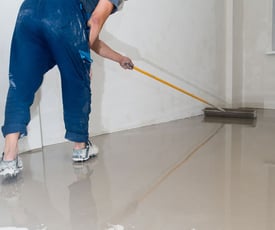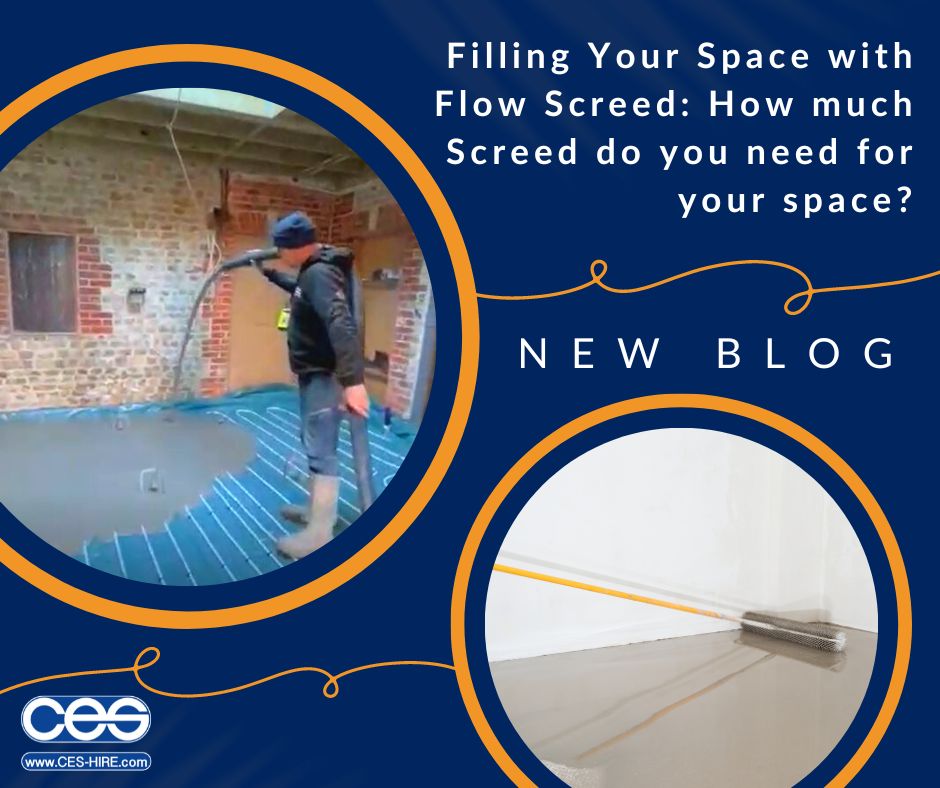Screed Pumps
Filling Your Space with Flow Screed: How much Screed do you need for your space?
Are you about to embark on a project that involves using liquid flow screed (also known as self-levelling or liquid screed)? If so, it's crucial to calculate the right amount of screed needed to ensure a successful outcome. In this blog post, we will guide you through the process of accurately determining the quantity of liquid flow screed required for your project. Remember this is just a general guide and for more specific support it is always worth contacting the product manufacturer. So, let's delve into the world of liquid flow screed to guarantee a smooth finish and efficient project.

Why is an accurate measurement important?
 Flow screed has become incredibly popular due to easy and rapid application as well as much quicker drying times compared to traditional screed; all in all this saves on time and labour. Read more about the benefits of flow screed here > Whilst speedy drying is a great advantage, if you have miscalculated your screed volume and find you don't have enough to complete your job you'll be in a sticky situation. It would be unlikely that a ready mix truck could deliver additional flow screed before your original batch goes off or if you're used bagged material getting your hands on more quickly enough may also be a challenge. Mixing batches is never recommended as it will compromise the quality and structural integrity of the floor. Equally if you over-calculate particularly when it comes to ready-mix, you may be charged for the surplus which the product manufacturer may not be able to do anything with. So the moral of the story is, always measure carefully and double check your measurements or get a second opinion.
Flow screed has become incredibly popular due to easy and rapid application as well as much quicker drying times compared to traditional screed; all in all this saves on time and labour. Read more about the benefits of flow screed here > Whilst speedy drying is a great advantage, if you have miscalculated your screed volume and find you don't have enough to complete your job you'll be in a sticky situation. It would be unlikely that a ready mix truck could deliver additional flow screed before your original batch goes off or if you're used bagged material getting your hands on more quickly enough may also be a challenge. Mixing batches is never recommended as it will compromise the quality and structural integrity of the floor. Equally if you over-calculate particularly when it comes to ready-mix, you may be charged for the surplus which the product manufacturer may not be able to do anything with. So the moral of the story is, always measure carefully and double check your measurements or get a second opinion.
How to calculate your Flow Screed Volume
Flow screed comes either from a ready-mix truck when your working with larger volumes or can be purchased as bagged material when you're applying in smaller spaces. Whichever type of liquid screed you require, you'll still need to carefully calculate the amount of material you need. Follow these steps below to work out your flow screed volume.
- Measure the area in square metres. To do this measure the length and width and multiply these two values together.
- Decide on the thickness you require. Depths can vary between 25mm-50mm depending on requirements and whether you're installing underfloor heating. The depth you decide on will need to be converted into metres so it's the same unit as your calculated area.
- Calculate the volume by multiplying the area (step 1) by the thickness (step 2). The volume is then given in cubic metres.
- Make allowances for wastage or uneven application. Wastage allowance is often 5-10%. To calculate this amount multiply the total volume (step 3) by 1 + the wastage percent divided by 100
- Convert to litres for a ready mix truck or into bags for bagged material. For ready-mix flow screed , 1 cubic metre is equivalent to 1000 litres. Bags may come in 20kg or 25kg bags so it will depend on the product you select as to how many bags you need.
For example, this is how you would go about calculating the volume required for a room measuring 4m x 6m when you're installing 40mm depth of flow screed and allowing 7% of wastage.
-
 Area: 4 m x 6m =24 m²
Area: 4 m x 6m =24 m² - Thickness: 40mm (converts to 0.04m)
- Volume: 24m² x 0.04m =0.96m³
- Wastage allowance: 0.96m³ x (1 + 7/100) = 1.0272m³
- Conversion: 1.0272m³ = 1027.2 litres (round this to 1028 litres to accommodate the 0.2 litres). If you're working with bagged material, check the specific manufacturers guidance to convert your kg bags to the correct volume. Weber 4310 have a great conversion calculator that will calculate how many bags are required, take a look here >
Ready-Mix Flow Screed Installs
Large flow screed installs can often be more cost-effective. Greater volumes will mean using a ready-mix truck to supply your material. Generally there is a minimum order requirement when using flow screed from a ready mix truck though this will vary between companies. Minimum order quantities can typically be around 1 cubic metre (approximately 1000litres). The reason for minimum orders is due to the cost and logistics required for delivery including mixing and transporting with specialised equipment. It may be worth considering using a smaller electric flow screed pump and bagged material if your project doesn't fall within those minimum requirements.


